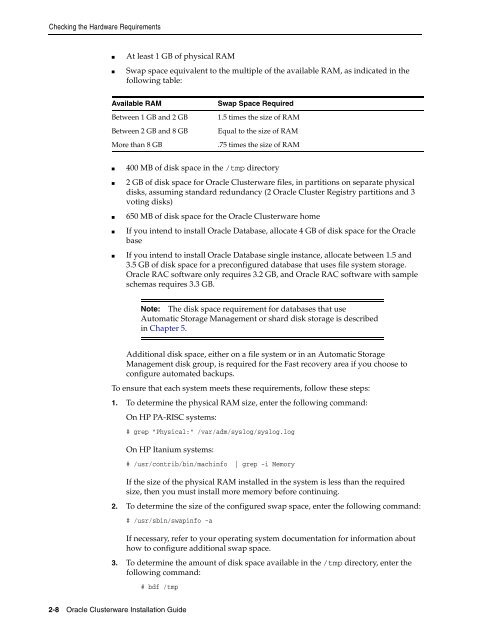Oracle Database Oracle Clusterware Installation Guide for HP-UX
Oracle Database Oracle Clusterware Installation Guide for HP-UX
Oracle Database Oracle Clusterware Installation Guide for HP-UX
Create successful ePaper yourself
Turn your PDF publications into a flip-book with our unique Google optimized e-Paper software.
Checking the Hardware Requirements<br />
■ At least 1 GB of physical RAM<br />
■ Swap space equivalent to the multiple of the available RAM, as indicated in the<br />
following table:<br />
Available RAM Swap Space Required<br />
Between 1 GB and 2 GB 1.5 times the size of RAM<br />
Between 2 GB and 8 GB Equal to the size of RAM<br />
More than 8 GB .75 times the size of RAM<br />
■ 400 MB of disk space in the /tmp directory<br />
■ 2 GB of disk space <strong>for</strong> <strong>Oracle</strong> <strong>Clusterware</strong> files, in partitions on separate physical<br />
disks, assuming standard redundancy (2 <strong>Oracle</strong> Cluster Registry partitions and 3<br />
voting disks)<br />
■ 650 MB of disk space <strong>for</strong> the <strong>Oracle</strong> <strong>Clusterware</strong> home<br />
■ If you intend to install <strong>Oracle</strong> <strong>Database</strong>, allocate 4 GB of disk space <strong>for</strong> the <strong>Oracle</strong><br />
base<br />
■ If you intend to install <strong>Oracle</strong> <strong>Database</strong> single instance, allocate between 1.5 and<br />
3.5 GB of disk space <strong>for</strong> a preconfigured database that uses file system storage.<br />
<strong>Oracle</strong> RAC software only requires 3.2 GB, and <strong>Oracle</strong> RAC software with sample<br />
schemas requires 3.3 GB.<br />
Additional disk space, either on a file system or in an Automatic Storage<br />
Management disk group, is required <strong>for</strong> the Fast recovery area if you choose to<br />
configure automated backups.<br />
To ensure that each system meets these requirements, follow these steps:<br />
1. To determine the physical RAM size, enter the following command:<br />
On <strong>HP</strong> PA-RISC systems:<br />
2-8 <strong>Oracle</strong> <strong>Clusterware</strong> <strong>Installation</strong> <strong>Guide</strong><br />
Note: The disk space requirement <strong>for</strong> databases that use<br />
Automatic Storage Management or shard disk storage is described<br />
in Chapter 5.<br />
# grep "Physical:" /var/adm/syslog/syslog.log<br />
On <strong>HP</strong> Itanium systems:<br />
# /usr/contrib/bin/machinfo | grep -i Memory<br />
If the size of the physical RAM installed in the system is less than the required<br />
size, then you must install more memory be<strong>for</strong>e continuing.<br />
2. To determine the size of the configured swap space, enter the following command:<br />
# /usr/sbin/swapinfo -a<br />
If necessary, refer to your operating system documentation <strong>for</strong> in<strong>for</strong>mation about<br />
how to configure additional swap space.<br />
3. To determine the amount of disk space available in the /tmp directory, enter the<br />
following command:<br />
# bdf /tmp
















